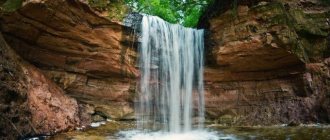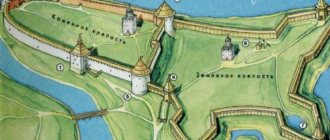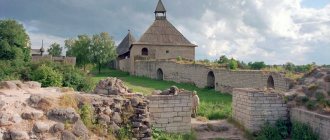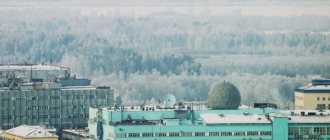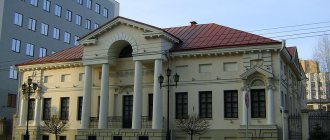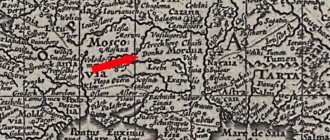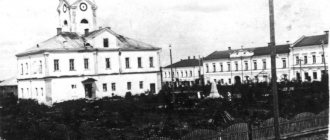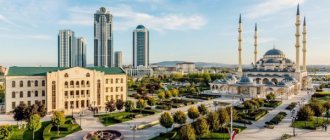Shlisselburg - a city in the Leningrad region. Its history is inextricably linked with Oreshek fortress — he arose at the same time as her and was always under her protection. People usually come to Shlisselburg for Oreshok, but it has many interesting sights that are worth seeing.
Even when you leave the Kola highway, the wide Neva catches your eye, and in the city there is also a network of canals. Along them are ancient and modern buildings of the Nevsky Shipbuilding and Shiprepair Plant .
Old factory building (shot from a bus window)
Network of canals and ancient hydraulic structures in Shlisselburg
A few facts about Shlisselburg
- The city of Shlisselburg was founded in 1323 on the shores of the largest lake in Russia after Baikal - Lake Ladoga and the Neva River, at the source of the Neva.
- Previous names of the city: Oreshek (1323 - 1611), Noteburg (1611 - 1702), Petrokrepost (1944 - 1992).
- After Peter I named the city Shlisselburg in 1702, for simplicity, people began to call it Shlyushin. This fact is reflected in Dahl’s Explanatory Dictionary and the Brockhaus and Efron Encyclopedic Dictionary.
- The population of the city is about 14.8 thousand people.
- The distance to St. Petersburg is about 48 km.
- There is Red Square in Shlisselburg.
How to get to Shlisselburg
To see the sights of Shlisselburg, you need to get to it:
- By car from St. Petersburg: along the M-18 “Kola” highway, after the Ladoga Bridge, turn right, sign for Shlisselburg. The length of the route is about 32 km. Travel time depends on the traffic situation.
- By bus from St. Petersburg: from the Ulitsa Dybenko metro station - bus No. 575 (every 20 minutes); from the Rybatskoye metro station - bus No. 440 (every 40 minutes).
- By train from St. Petersburg: from Finlyandsky Station you need to go to the Petrokrepost station (located on the opposite side of the Neva). Travel time is 1 hour 10 minutes. However, you need to remember that Petrokrepost is located on the opposite bank of the Neva. Then you can get to Shlisselburg only through a ferry.
Sights of Shlisselburg
The former Gostiny Dvor (late 19th century, engineer V.N. Bobrov)
Shlisselburg is a city that is of interest primarily to those who are interested in history. The most interesting sights of Shlisselburg are the Oreshek fortress, which is a medieval monument of fortification architecture, and canals built as an alternative to the waterway along Ladoga.
View of the Oreshek fortress
Shlisselburg is surrounded by the Neva, Lake Ladoga and is riddled with canals, rivers and streams. It has many berths, navigation is carried out from May to October.
What to see around Shlisselburg
It’s quite difficult to get tired of walking around Shlisselburg, since the town is really small, and its attractions are completely grouped in the very center. On average, three hours will be enough to examine them. However, the journey can be continued in the outskirts of the city. Therefore, while Nut is sleeping, you will have to choose a different direction.
If you go straight, you will get to Ladoga. If you go left, you will get to the Steel Road monument, an ostrich farm, the Osinovetsky lighthouse or a wonderful beach. If you go to the right, you will get to the Sinyavinsky Heights, you will see the Alexander Lighthouses and the abandoned “Russian America”. However, more on this in another article.
Fortress Oreshek
Website: www.spbmuseum.ru Opening hours: daily from May 1 to October 31 from 10.00 to 18.00, on weekends and holidays until 19.00. Ferry to Orekhovy Island: 300 rubles, students, pensioners - 200 rubles, schoolchildren - 150 rubles. , up to 7 years - free. Entrance fee to the fortress: 250 rubles, schoolchildren, students, pensioners - 150 rubles, under 7 years old - free.
The Oreshek fortress is located on Orekhovy Island at the source of the Neva, and the city of Shlisselburg itself is a few hundred meters away on the mainland. You can only get to the island by water transport: by motor ship or boat.
The ancient and beautiful Oreshek fortress is included in the UNESCO World Heritage List and is an object of cultural significance of the Russian Federation of federal significance. This is a monument to ancient Russian architecture and fortification from the time of Peter I; there was a terrible prison for political prisoners here, and here the fate of besieged Leningrad was decided.
The fortress was first mentioned in chronicles in 1323. It was built by the Novgorodians and was an outpost of the Russian land. In 1612, it was captured by the Swedes and renamed Noteburg (Walnut City). 90 years later, in 1702, the fortress was taken by storm by Russian troops with the participation of Emperor Peter I and received the name Shlisselburg (Key City).
After the construction of the Kronstadt fortress on Kotlin Island in 1723 with its system of defensive forts, the Shlisselburg fortress lost its military significance and turned into a political prison - its fate is very similar to the Peter and Paul Fortress. Already under Peter I, his sister Maria sat here, and after his death, his first wife Evdokia Lopukhina, who was kept here by the second wife of the Emperor Catherine II.
The most famous prisoners of Shlisselburg are the deposed Emperor John VI, who is often called the Russian Iron Mask, and the Narodnaya Volya terrorists who participated in the assassination attempts on Emperor Alexander II. Lenin’s brother, Alexander Ulyanov, was also executed here for the assassination attempt on Alexander III.
New prison
After the February Revolution of 1917, the prison in the Oreshek fortress was closed. A branch of the Museum of the Revolution was opened here, and after its closure, an ammunition depot was opened. On September 8, 1941, the Germans entered Shlisselburg and the blockade of Leningrad began. They did not pay attention to the old abandoned fortress, which the 1st division of the NKVD troops took advantage of, occupying the island and creating an active defense here. Together with the sailors of the 409th naval battery of the Baltic Fleet, the fortress heroically defended itself for 498 days and was not surrendered to the enemy.
The Oreshek fortress was of utmost importance in the defense of Leningrad; it protected the Road of Life - the only transport connection between Leningrad and the country. The road of life passed along Lake Ladoga a few kilometers from the fortress. On May 9, 1985, a memorial complex was opened here in honor of the heroic defenders of the fortress.
Monument to the defenders of the fortress
Now on the territory of the fortress there is a branch of the State Museum of the History of St. Petersburg. The island is accessible for inspection only in the warm season: from May to October. During the Great Patriotic War, the fortress was severely destroyed. It began to be restored only in 1966, but complete reconstruction is still far away. The fortress continues to collapse and collapse due to funding problems.
There are two prison premises available for inspection: the Secret House and the New Prison. You can walk along the restored section of the fortress wall.
Ladoga promenade
Cost: 150 rubles, students, schoolchildren, pensioners - 100 rubles.
For an additional fee, you can walk along the Ladoga Promenade - a wooden path along the fortress wall between Golovkina and the Royal Towers. Here you can see the most beautiful views of the fortress, Shlisselburg and Ladoga.
Monuments and memorial sites of Shlisselburg
In a city that is a military worker there cannot but be monuments, memorials and memorial sites. Shlisselburg, who was at war, carefully preserves the memories of its heroes.
Monument to the defenders of the fortress
- Address: Orekhovy Island.
The obelisk ball is installed on the territory of the temple. It contains bas-reliefs depicting soldiers of that time. This is part of the memorial complex dedicated to the staunch defenders of Oreshok, who fought to the death in 1941-1943.
In almost 500 days of fighting, 350 Soviet soldiers, led by Captain Chugunov and Commissar Marulin, did not surrender their positions to the enemy.
Thanks to the power of its walls and the heroism of its soldiers, the fortress never fell to the Nazis. The significance of this feat is difficult to overestimate - the “Road of Life” passed here, which became the only thread connecting besieged Leningrad with the mainland.
Monument to Peter I
- Coordinates: 59.945972, 31.030542.
The monument to the great reformer was erected in the city in honor of the 250th anniversary of Leningrad. This happened in 1957. Peter I in the uniform of the Preobrazhensky Regiment. Dress uniform, boots, broadsword at the side.
In the king's left hand is a telescope. The right one squeezes the cane, leaning on it. The chest is decorated with the Order of St. Andrew the First-Called.
The monument is the first building of the Soviet era dedicated to persons of royal blood. It is located near Petrovskaya pier. The Staraya Ladoga Canal and its structures are also located here. They were built under the leadership of the king himself. Construction work began in 1719.
Monument to Savva Vladislavich-Raguzinsky
- Address: Staroladoga Canal Street.
Companion of Emperor Peter. A well-known public figure, a Serb who participated in the preparations for the Battle of Poltava. Engaged in negotiations with the ruling dynasties in the Balkans. Helped Russia win the war with Turkey. Established relations with China.
Memorial Cross to the soldiers who fell during the storming of Noteburg
- Address: Orekhovy Island.
Noteburg - this is what the Swedes called the city after the fall of the fortress in 1612. Traditions say that when leaving the borders, their defenders walled up an icon of the Mother of God of Kazan in the walls of the fortifications - in order to return.
The fortress became Russian again after the Northern War. In the autumn of 1702, after a battle that lasted 13 hours, the stronghold fell and the Swedes were expelled. In honor of this victory, a memorial Cross was erected on one of the elevations in the fortress, at the burial place of the soldiers of the Semenovsky and Preobrazhensky regiments who fell during the assault on Oreshok.
Monument to fallen revolutionaries
- Address: Oreshek fortress.
The memorial was opened back in 1919. It is located at the bastions of the Oreshek fortress, next to the Royal Tower. The location for the monument is not accidental. The remains of revolutionaries who died in 1884-1906 are buried here. in a fortress-prison.
After the revolution of 1905, the fortress was turned by the authorities into a real hard labor camp. The small barracks, converted into a prison building, had three floors. The convicts called this prison “Menagerie,” which was not far from reality.
The cells here were separated from the corridor by bars. The metal bars started at the very floor and ended at the ceiling of the prison. 15 fighters for a better life were executed in the prison. Many left on their own or died, unable to withstand torture and torture.
Monument to river workers
- Address: Novoladozhsky Canal.
The youngest Shlisselburg memorial. It was opened in the spring of 2022. This is the first monument to river workers. For many years, these people, regardless of the vagaries of the weather, lit fires that showed the way for ships. Their seemingly inconspicuous work helped river and lake shipping in Russia. The monument is located near the Novoladozhsky Canal. A boat cast from metal is installed on the dam. A beacon man sits in it, lighting the way for the ships. This is the first such memorial in the world.
Memorial complex dedicated to the defenders of the Oreshek fortress
- Address - o. Walnut.
In the summer of 1941, the Oreshek fortress became an insurmountable barrier for the fascists rushing towards Leningrad. Having captured it, the Germans would have completely closed the blockade ring, cutting off the northern capital of Russia from the mainland. The soldiers of the First Division of the NKVD became an obstacle to the enemy. The artillerymen of the naval Baltic battery fought with them shoulder to shoulder. They held the fortress for almost 500 days, giving hope for life to the Leningraders.
The memorial at the site of the fighting was opened in 1985. The complex was installed inside the destroyed St. John's Church. It includes the “Oath” - a sculptural group located next to the obelisk. On the memorial sign, in the shape of a ball, there are bas-reliefs with the faces of the soldiers who defended the stronghold. The complex also includes a mass grave where the remains of 24 heroic defenders of Oreshok are buried.
Admiralty anchor
- Address: Red Square.
Raised from the bottom of the Neva, in close proximity to Shlisselburg, a rarity. This piece of ship equipment dates back to the reign of Tsar Peter I. It was installed at the locks, near the Petrovsky Bridge.
Staraya Ladoga Canal
The Staraya Ladoga Canal stretches along the shore of Lake Ladoga from the city of Novaya Ladoga to Shlisselburg and connects the Volkhov and Neva rivers. The length of the canal is 117 km.
The canal was built by Peter I at the beginning of the 18th century to connect the Volga and the Baltic Sea. Lake Ladoga is very turbulent, with strong winds, the waterway along it was dangerous, so an alternative to it was built - the Ladoga Canal, later renamed Petrovsky, and the Staraya Ladoga Canal.
Petrovsky Bridge over the Staraya Ladoga Canal
The construction of the canal became another grandiose hydraulic structure of the Petrine era, along with the Petrovsky Dock in Kronstadt. It was officially opened in 1730 by Anna Ioanovna. It was the largest in Europe.
Currently, the canal is almost completely overgrown and dry, and has not been used for shipping for a long time. Next to it, at the junction of the canal and the Neva, there is a monument to Peter I - construction of the canal began here in 1719.
The monument to the emperor was erected in 1957; it is notable for the fact that it is the first monument to the tsar erected in Russia after 1917.
Monument to Peter I: a familiar silhouette
Address: st. Novoladozhsky Canal
Sculptor Antokolsky created a model of the monument back in 1872. Sculptures were created from it, which were installed in Peterhof and Astrakhan; copies of the model were accepted for storage by the Russian Museum and the Tretyakov Gallery.
The statue was installed in Shlisselburg only in 1957. This is the first monument to the Tsar on the territory of the USSR after the victory of the 1917 revolution.
The image of this monument is familiar to all Russians - it adorns the 500 ruble banknote.
Novoladozhsky Canal
The Novoladozhsky Canal was built to replace the old one. It stretches parallel to the Staraya Ladoga Canal closer to Lake Ladoga. Construction began on May 28, 1861 from the Shlisselburg side. On September 1, 1866, the grand opening of the canal took place in the presence of Alexander II.
The Novoladozhsky Canal is used for small vessels with shallow draft and is part of the Volga-Baltic Waterway. The length of the canal is 110 km.
Red Square
Red Square in Shlisselburg is the main square of the city; the main attractions of Shlisselburg are located around it. There is an ancient temple complex here: St. Nicholas Church, Annunciation Church and Kazan Chapel. The Staraya Ladoga Canal divides the square into two parts; you can cross the Petrovy Bridge to the other part of the square. Here is a square and the first monument to Savva Raguzinsky.
Peter the Great's comrade-in-arms, Savva Lukich Vladislavich-Raguzinsky, or Count Raguzinsky (1669-1738), successfully served the emperor in the diplomatic and trade fields. It was he who brought the little Abyssinian Ibrahim from Constantinople and presented him to Peter I, who became the tsar's confidant. Abram (Ibrahim) Hannibal is the great-grandfather of the great Russian poet Alexander Sergeevich Pushkin.
Monument to Savva Raguzinsky
Address: between st. Zhuk and the Staraya Ladoga Canal
This versatile, talented man devotedly served Peter I. In the diplomatic service, he negotiated on behalf of the Tsar with the governments of Rome and Venice, and headed the Russian embassy in China. In the trading field, he achieved a Russian monopoly in the supply of fox fur to France, Spain and Venice.
As the owner of a high aesthetic taste, Peter I entrusted him with ordering sculptures for his Summer Garden and hiring Italian craftsmen to install them. As a gift from the Pope, he accepted a statue of the Tauride Venus (now it is kept in the Hermitage). But he made his greatest contribution to the culture of Russia without even knowing it - he bought in Africa and landed on the Russian shore the little slave Abram Hannibal, the great-grandfather of the great Pushkin.
Blagoveshchensky cathedral
Address: Red Square, building 1
The Annunciation Cathedral is another place to visit on the list of Shlisselburg attractions. It is the main temple of the city. Built in the Baroque style, construction time: 18th century. A hundred years after its construction it received the status of a cathedral.
In the first years of Soviet power, the Annunciation Cathedral was closed, and the building was used as a food warehouse. During the Second World War it was opened again at the request of local residents, but after the war it was closed again. Services in the cathedral began again in 1991.
St. Nicholas Church
Address: Red Square, building 2
St. Nicholas Church or the Church of St. Nicholas the Wonderworker is part of the Shlisselburg temple complex. It got its name from the icon of St. Nicholas the Wonderworker, which was kept in the church until 1933. In this year, the temple was closed by a decision of the authorities, and the building was used for another purpose. It was returned to believers in 1995.
Initially (in 1739) there was a wooden church here, which was then moved to the village of Gavsar. And on this site in 1770 a stone building was built, which has survived and is in use to this day. The peculiarity of the stone building was that it was warm and was intended for holding services in winter.
Kazan Chapel
Address: Red Square, building 1
The Kazan Chapel in Shlisselburg is the third part of the temple complex of the Annunciation Cathedral and St. Nicholas Church. The chapel was erected in 1864 by the architect Ershov. At one time, the icon of the Kazan Mother of God was kept in it (hence the name). On religious holidays, a procession of the cross took place with her, which began from the chapel and ended in the fortress Cathedral of the Nativity of John the Baptist.
The Soviet government closed the chapel in the early thirties of the last century, but in the late eighties, at the request of believers, it was restored and returned to the church.
During the Great Patriotic War, the chapel was heavily damaged and restored in 1961 as an architectural monument.
Self-guided walking route
The most interesting place in Shlisselburg is the town center. It is better to start your independent sightseeing from the small Red Square.
- View the monument to S. Raguzinsky - a public figure in Russia during the times of Peter the Great.
- To the right of the monument are the houses of merchants Leontyev and Naumov - yellow buildings of 2 and 3 floors.
- Aznachevsky's house is a gray building.
- Across Zhuka Street is the Gostiny Dvor building (Dixie store).
- Walk along Zhuka Street to the intersection with Chekalova Street
- Further to the Neva - Victory Park with an exhibition of anti-aircraft guns, a monument to V.I. Lenin.
- The house of merchant Potashov is a three-story yellow mansion.
- Monument to ships that sank during the war on the road to the siege survivors.
- Monument to Peter I.
- City pier. You can go to the fortress island.
- Return along the embankment of the Staraya Ladoga Canal to the Petrovsky Bridge.
- Admiralty anchor from Peter's times.
- From the bridge across the road you can see the monument to S.M. Kirov.
- Walk in the opposite direction, but on the other side of the canal to the Neva. Along the bank of the Neva there are the remains of a chain pedestrian bridge connecting the bank of the Neva with a narrow elongated spit.
- Cathedral complex of the Annunciation Cathedral, St. Nicholas Church, Kazan Chapel.
- Along Krasny Avenue you can walk to Fabrichny Island - a complex of factory buildings.
- At the entrance of the plant there is a museum of the history of Shlisselburg.
- Across the road from the island is the Vodnik stadium, built in the mid-19th century.
- The beginning of the Malonevsky Canal, connecting the Staraya Ladoga Canal with the Neva River.
- The Humpbacked drawbridge of 1841.
This ends the walking tour through the historical places of the central part of Shlisselburg. If you cover all the objects, the distance will not exceed 3 km, but the impressions will last for a long time.
Echoes of great battles
Address: intersection of Chekalov and Zhuka streets
Next to the Lenin monument there is an exhibition of the Military Technical Museum “Echoes of Great Battles”. Anti-aircraft guns from war and post-war times are collected in the open air. They were dismantled from the ships and restored at the Nevsky Shipyard in Shlisselburg. Installed in the city for the 60th anniversary of the Great Victory.
Shlisselburg History Museum
Website: lenoblmus.ru Address: Fabrichny Island, 2A. Opening hours : from 09.00 to 18.00, Saturday from 11.00 to 17.00, Sunday - closed. Ticket price: 60 rubles, pensioners - 30 rubles, under 16 years old - free.
The museum building formerly housed the passage of a calico printing factory, which is now classified as a monument of industrial architecture of the 19th century. The museum's exhibitions are dedicated to the history of the city's development.
The museum conducts sightseeing bus and walking tours around the city and in the Oreshek fortress.
Excursion routes
It is up to the tourist to decide which type of excursions to use, group or individual. The latter are more expensive, but more informative and interesting; you can always ask a question and immediately receive an answer.
Below is information about an indicative excursion program within Shlisselburg with a visit to the fortress. As well as types of individual tours for organizing transport with prices for 2022. The point of collection of tourists and delivery after the excursion is determined by the client.
| Program | Duration, min. | Group number of tourists, people. | Duration, hour. | Services | Transport | Cost of an individual tour, rub. |
| Road from St. Petersburg | 60 | 1 – 6 | 6 | Guide | Tourists | 6600 |
| Water crossing to the Oreshek fortress | 15 | 1 – 3 | 6 | Guide, driver | Firms, passenger cars | 13000 |
| Exploring the history of the fort | 120 | 1 – 3 | 6 | Guide, driver | Firms, business class | 15200 |
| Water crossing to Shlisselburg | 15 | 1 – 6 | 6 | Guide, driver | Firms, minivan | 14300 |
| Lunch at a cafe | 30 | 7 – 15 | 6 | Guide | Tourists | 7200 |
| Excursion around Shlisselburg: Fort Oreshek, the Staraya Ladoga Canal and its locks, three objects of Christianity, a monument to Peter I, Victory Park. | 45 | 1 – 15 | 6 | Guide, driver | Companies, minibus | 15800 |
Group trips of 20-50 tourists are carried out on comfortable buses. Firms often gather tourists at 1 or 2 stops at a certain time. The cost for 2022 in different travel agencies varies from 1600 to 2000 rubles. per tourist.
When purchasing a voucher, you need to check to see if there are discounts, especially for groups of 4-5 people. Approximate program of a tour to the settlement and fortress.
| Program | Duration, min. |
| Tourists boarding at the 1st stop | 15 |
| Road and landing at the 2nd stop | 15 + 15 |
| Road to Shlisselburg | 45 |
| Sightseeing tour of the settlement | 30 |
| Moving to the island | 30 |
| Overview of the fortress museum | 120 |
| Moving to the settlement | 30 |
| Lunch at a Shlisselburg cafe | 60 |
| Visit to the diorama museum and reserve “Breaking the Siege” | 60 |
| Road to St. Petersburg | 60 |
In both cases, firms do not cover tourists' expenses for certain types of services. Transportation and a ticket to the museum are free for children under 7 years old.
- Water crossing in both directions - 250 rubles, for beneficiaries - 200 rubles.
- Tickets to the fort - 200 rubles, for pensioners and students - 100 rubles.
- Lunch in a cafe – from 700 rubles. per person.
Museum-Reserve "Breakthrough the Siege of Leningrad"
Website: lenoblmus.ru Address: Kirovsky district, Maryino village.
A few kilometers from Shlisselburg, opposite the Ladoga Bridge over the Neva River, there is the “Breaking the Siege of Leningrad” museum. During the Great Patriotic War, Shlisselburg found itself at the center of hostilities. The beginning of the siege of Leningrad is counted from September 8, 1941 - the day of the capture of Shlisselburg by the German group “North”.
The museum's exposition is dedicated to the military offensive operation of the Soviet troops "Iskra", carried out from January 12 to January 30, 1943. During the operation on January 18, the armies of the Leningrad and Volkhov fronts in the Shlisselburg area united, the blockade of Leningrad was broken. Now the city was connected to the country by a corridor 8-11 kilometers wide, which made it possible to ensure the supply of the city.
In 17 days, the Shlisselburg highway was built - a railway line 33 kilometers long from Shlisselburg to Polyany. Trains with food went along it several times a day to Leningrad. The first train arrived at the Finnish station on February 7, 1943, which radically changed the situation of Leningrad residents and military units surrounded.
Diorama “Breaking the Siege of Leningrad”
The diorama museum “Breakthrough the Siege of Leningrad” opened in May 1985. The diorama was created by Leningrad artists, many of whom were direct participants in the events described.
Fragment of the diorama “Breaking the Siege of Leningrad”
In 1990, on the basis of the diorama, the “Breakthrough the Siege of Leningrad” museum-reserve was created. Currently it includes the following objects:
- Tank exposition in front of the diorama;
- Diorama “Breaking the Siege of Leningrad”;
- Memorial complex "Nevsky Piglet";
- Memorial complex "Sinyavinsky Heights".
Museum-diorama Breaking the siege of Leningrad
On January 18, 2022, a new museum pavilion was opened, dedicated to breaking the siege of Leningrad. It housed two halls: a multimedia hall and one with a three-level 3D diorama reflecting episodes of Operation Iskra.
The new diorama “Breaking the Siege of Leningrad” uses acoustic techniques that reflect the sounds of a night battle (the whistle of bullets, the roar of shells, the howl of a siren).
Modern objects interesting to visit
Shlisselburg, whose sights attract tourists from all over the world, will be of interest not only for its historical events; visitors will be curious to know what they can do in their free time from excursions. On the territory of the settlement there are active recreation areas that will be interesting for tourists.
1. Paintball, Laser Tag club "Blockade" was created on the basis of a former military unit near the Ladoga Bridge. The club has a large area in a forested area. War games are organized - experienced instructors come up with picturesque game settings.
There are places for spectators, picnics, and sports games of volleyball and basketball. Separate area with water activities: fishing, boating. There is a playground for children.
2. In 2022, the Aquatoria shopping and entertainment complex was opened - this is the only complex of this kind in a small settlement. The complex is located at Zhuka Street, building 4 on the banks of the Staraya Ladoga Canal and the Neva, on one side it borders on Victory Park. Modern, beautifully decorated 3-story building with glass elevators and escalators. On its territory of 7700 m2 there are:
- the shops;
- jewelry salon;
- pizzeria Dodo-Pizza, foot court;
- Fly Gym trampoline and gymnastic center;
- Funky Panky Children's Center.
3. Mini-hotel and club “Starhouse” , on Chekalova street, building 14. Although it is located in the city center, it can offer a small outdoor pool, a fountain, a garden and a delightful tea house. In a separate area of the hotel there is a sauna, hookah room and billiard table. It is possible to rent a bicycle and ride along the streets with a long history.
